Mac Musings
Thinking Too Different: Why Mac Users Are Slow to Adopt OS X
Daniel Knight - 2003.06.03
I worked at a local publishing house for 8-1/2 years, first as a book designer doing Mac support on the side, later as the IS Manager doing book design on the side. By the time I left that job, we had 90+ Macs in three locations.
I was also helping put together a proposal for a Citrix system, which would let us move parts of the company to Windows, which the head of our marketing department was convinced was an essential step in functioning in the real world of business. (Needless to say, I completely opposed this.) I left long before that was implemented, and I'm glad I don't have to deal with viruses, worms, sluggishness, and other problems associated with running Windows from a shared server.
In my opinion, that's absolutely the wrong model for personal computing. It's the old mainframe and minicomputer model that essentially uses terminals tied to a central computer that does all the real work. Citrix and other solutions for sharing Windows on a server work much the same way, although the display processing can be handled by the client computer.
Pournelle's First Law of Computing is "at least one CPU per user." That is, every computer user should have a computer that does the work instead of tying into a shared application server that does the bulk of the work. Sharing files on a server, sharing a database over a network, and occasionally running an application on a remote server is okay, but the core of the personal computing paradigm is that the power is on your desktop.
Unix, which forms the core of Mac OS X, is rooted in the server mentality. It's designed from the ground up to support multiple users and never crash. That's why OS X users have to log into their computers, something that was never necessary with the classic Mac OS. (Yes, Apple had some multiuser support in the classic Mac OS, but nothing as powerful as OS X offers.)
The best thing that ever happened to Unix was being liberated from
the Big Computer, put on a Personal Computer, 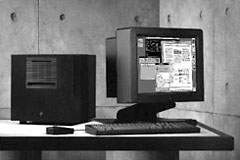 and getting a graphical user interface. Fifteen years
ago, Steve Jobs unveiled the NeXT
computer to the world as one of the first personal computers to run
Unix and include a graphical user interface.
and getting a graphical user interface. Fifteen years
ago, Steve Jobs unveiled the NeXT
computer to the world as one of the first personal computers to run
Unix and include a graphical user interface.
This was the era of Windows 2.0, and NeXT was deliberately designed to compete with the four year old Mac OS. A lot of things were done differently. Sometimes that was to improve things. Sometimes that was to make it hook into Unix more easily. And sometimes is was to be different, to try something new, to experiment with the user interface.
Mac OS X
That's the background for Mac OS X. When Apple acquired NeXT in late 1996, they acquired a mature operating system that had evolved separately from both Windows and the Mac OS. It took nearly four years to port NeXTstep over to the PowerPC and get the classic environment running within OS X.
The beta, released in September 2000, held a lot of promise and created a lot of frustration. It was rock solid, but it didn't work with a lot of third-party hardware, and there was very little software available for it. Worse yet, it broke a lot of Macintosh Human Interface Guidelines, forcing Mac users to learn new ways to do familiar tasks.
When 10.0 shipped in March 2001, Apple showed that they had heard our complaints. The useless Apple icon in the middle of the menu bar was back where it belonged. There was a bit more hardware support. And with six months of the Public Beta, there was a lot more software available.
But it still had a lot of rough edges. It was stable. It was pretty. It was sluggish. And it remained very different from the classic Mac OS.
Through 10.1 and 10.2, things got better. We now have lots of native OS X programs to choose from. Quartz Extreme attacks sluggishness on the interface front, which is where it was especially pronounced. A lot more classic Mac features have made their way into OS X - and it remains very different from the classic Mac OS.
Forward or Backward?
Four members of my household now have OS X on their computers. I pretty much live in OS X on my 400 MHz PowerBook G4, and with the exception of uploading site changes within Claris Home Page, I find classic applications (which I use for most of my work) sometimes work better inside OS X and the classic environment than they did under OS 9. (I attribute much of this to the fact that OS X uses as much free memory as it can for caching files.) I've been an OS X users, not just a dabbler, since I got a copy of 10.2 in January 2003.
Rant the First
My wife's 14" iBook 600 came with 10.1 when she bought it in early 2002. And it should be easy for her to migrate, since she does almost all of her work in AppleWorks, MYOB Account Edge, browsers, and instant messengers, all of which are X native. She still loves Claris Emailer, though, so she'll probably be using classic mode for at least that if she ever makes the switch to OS X.
I don't think that's going to happen soon. Linda has been using Macs since my Mac Plus days. She's become familiar with how it works and comfortable with the classic Mac OS. Her 'Book rarely locks up under OS 9, and she's got everything working just so. There's no compelling reason to migrate to OS X.
There could be. She runs a small adoption agency, two of her employees work from their homes, and iCal could make it a lot easier to check each other's schedules. All of her Macs (two 366 MHz indigo iBooks, her 14" iBook, and a 333 MHz blueberry iMac) have enough horsepower and RAM (192 MB and up) to handle Jaguar, which is required to run iCal.
Every few months she'll try to use OS X for a day, just as I did last year. But she's not a geek; she's a user. She doesn't follow the Mac Web to learn about getting the most out of her computer. She doesn't sit down with massive tomes explaining the intricacies of OS X. She's a user, and the Mac has never required here to do much more than use it.
She knows how to use the Chooser, but where the heck do you choose your printer in OS X? And how the heck do you connect to the file server? Both are much harder to figure out in OS X - I've been using X full time since January, and I still find it hard to remember where some of these settings are. And I'm the family Mac geek.
She likes Safari, which she used for the first time on Saturday. She can run Yahoo Messenger. But then comes the frustration. AppleWorks didn't know where her user dictionary was, and we spent 20 minutes figuring out where it was so she could use it. This is exactly the same user dictionary that AppleWorks used in the classic Mac OS. Why can't it automatically use the same dictionary? And why does it keep displaying that blasted "Starting Point" thing despite the fact she's turned it off time after time?
Fonts are the next problem. There are probably some font conflicts, but I can't find a freeware or shareware program to help me diagnose it. But some of her fonts didn't work until I deleted some other (unneeded) ones. And the font that she uses for all of her business documents, Sabon, doesn't work at all inside OS X - yet it works flawlessly on my computer.
Rant the Second
The other drawback is that she's a Tournament Director in our online euchre league, and some of the features of Yahoo Messenger are only accessible to Windows users. So she uses Virtual PC, and the version we have isn't compatible with OS X. Since Yahoo doesn't seem to care about feature parity for Mac users, that means booting into the classic Mac OS any time you need to use the more advanced Yahoo Messenger features.
Of course, both classic Mac OS users and OS X users are treated as second class citizens in the world of Yahoo Messenger. We get the basics (chat, webcams) but not the powerful stuff (URLs that work, sending a message to a whole group, voice chat, and automatic message archiving).
(Yeah, I know about Fire. It was one of the first OS X applications I downloaded when playing with the Public Beta. I like it, and Linda's going to try it. It doesn't support her webcam, but it does message archiving and some other useful things.)
Rant the Third
And then she tried to save a document. Do the folks at Apple have any clue how unnerving it can be to go to their stark Save dialogue box - especially for someone who has been living with the power of Default Folder on the classic Mac OS for years?
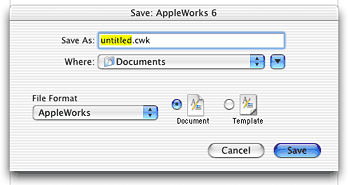
There's not even a list of files within the currently selected folder - except for a place to name your file, this is pretty alien looking to the typical Mac user. And clicking on Where: Documents isn't particularly helpful. The options are Desktop, Home (where's that?), iDisk, Favorite Places, and Recent Places. The latter two list additional directories.
Expanding the Save dialogue isn't a whole lot more helpful to someone used to the classic Mac OS. It looks like this:
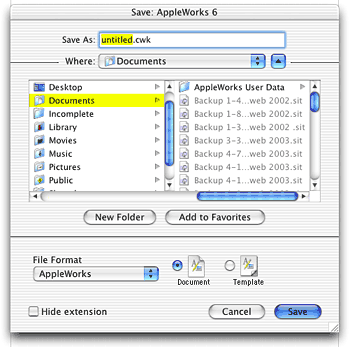
This may have been a logical way for geeks and NeXT programmers to list files and folders, but it's completely alien to Mac users. Not only does it look strange, but if you're not careful, you can suddenly end up in the wrong directory. This is abominable. We complained about this in the beta; three major revisions later it's still the default.
Contrast that with the save dialogue in the classic Mac OS. It's stark in its simplicity, yet it's also powerful:
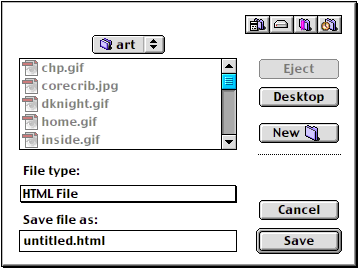
We're in a folder named art. By clicking on the name of the folder, we can zip up through the hierarchy of directories right to the desktop. By scrolling through the list of files, we can choose any folder within the current directory. Even the additional power added by Default Folder (those four icons near the top right) doesn't detract from the simplicity of the interface while adding incredible power.
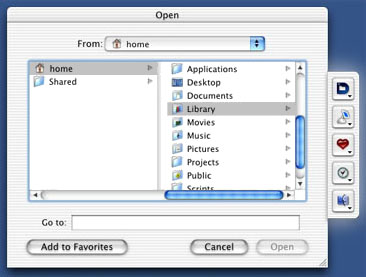
I tried Default Folder X several months ago, and I used the demo until it expired. At the time I was still doing the bulk of my work in classic applications, so I was rarely subjected to the OS X Save dialogue. Maybe if I learn exactly how the Favorites feature of OS X works, I'll find out that I don't need Default Folder X, but I suspect it will become as essential to productive OS X work as the classic Default Folder is with the classic Mac OS.
This is just another example of Apple ruining a perfectly usable, easily understood interface in exchange for something more powerful and more complex that can readily confuse and intimidate longtime Mac users.
Although there have been a lot of improvements in wheels over the years, the shape remains the same. The elegance of the classic Mac OS is much the same; I cannot understand why Apple thought they had to put flashy rims and wide tires on the family minivan.
The Beige G3
My youngest son, Tim, uses a beige G3/266 upgraded with a 333 MHz CPU - and I haven't tried chipping it to 366 or 400 MHz yet. Tim goes back and forth between 9 and X. His home schooling curriculum is Windows based, so he's got to use OS 9 and Virtual PC there. Other than that, he prefers OS X. He's got Jaguar, Yahoo Messenger, AppleWorks, and probably some game emulators as well.
I spent several hours on it over the weekend, trying to figure out how to partition the 20 GB Barracuda drive properly, move OS X over using Carbon Copy Cloner, and free up the 30 GB IBM DeskStar for the iMac 333 in my second son's room. With or without the Acard Ahard, we were unable to get things working as we wanted, so we left the DeskStar connected to the G3's 16.67 MBps IDE bus and removed the Seagate Barracuda.
Running a 17" monitor at 1024 x 768, Tim's pretty happy with this setup. He doesn't print much, but we have everything set up for the LaserJet 2100TN.
Newest: The iMac 333
The goal was to put the newer, larger, faster IBM DeskStar in the iMac 333, but the path of least resistance was not to do so. Instead we ripped open our famous iMac, the one that refuses to acknowledge the same 256 MB module that works in another iMac 333 and a WallStreet, and did some upgrades.
We replaced the bottom RAM chip, which is a bear to get at, giving it 128 MB down there. It still wouldn't work with the 256 MB module up top, so we ended up putting a 64 MB module (pulled from the WallStreet when it got a 256 megger) on top for a total 192 MB. A bit tight for OS X, but a world better than the 64 MB Brian had been using.
Then we pulled the stock 6 GB hard drive and dropped in the 20 GB Barracuda, which we partitioned into thirds. Each 6.6 GB partition was to hold a different OS: OS X on the first, OS 9 on the second, and eventually Yellow Dog Linux on the third.
As with the beige G3, things didn't work as planned. We can boot OS 9 from the first partition, but not from the second. So now Brian has OS 9.2.2 and Jaguar on his first partition. I would have made it bigger if we'd known we'd run into this.
Brian just graduated high school, hopes to buy an iBook before starting college in the fall, and wants to get comfortable with OS X. He's used it on my TiBook (both Brian and Steve love to burn CDs, and I have one of two CD-RW drives in the house), and now he's got it in his bedroom.
Like my wife, he's mostly dabbled in OS X thus far. He's more of a geek than she it, but far less than me. He's been downloading updaters and programs, and he's been griping about how sluggish OS X is compared with OS 9. He already knows that one reason he'll be buying an iBook is that he's so comfortable in OS 9 that he sees no reason to change - but he also wants to be ready for the future.
I still don't have a clue why we can't boot from the second partition. I hope we won't have problems with YDL when Brian gets it. This was an unexpected frustration.
Why Mac Users Aren't Switching
Over the past week the Mac Web has been busy asking the question, "Why aren't Mac users moving to OS X?" Some of the suggestions are sensible; a few seem pure nonsense. It took me a year, and watching my family get familiar with OS X brings back a lot of memories.
In my opinion, the top reasons Mac users aren't switching to OS X:
- They don't have any reason to. The classic Mac OS works just fine for them. Why mess with success? They may even have Macs that shipped with OS X, have tried it, and still see no reason to use it.
- They don't know that they can run OS X on their Mac. There's a
common misperception that you can't run a new operating system on old
computers.
- A subset of this is people who just run whatever OS came with their computer - thank goodness we have Software Update to handle a lot of updates automatically.
- Another subset is people who could run OS X on their Macs and clones, especially accelerated ones, using XPostFacto, but they believe that it won't work on their old Macs because Apple doesn't officially support it.
- They can't run OS X on their old hardware.
- An essential application isn't available in an OS X version, there's no alternative, and it either doesn't work at all or works very poorly in classic mode.
In a universe of 25-30 million Mac users, Apple estimated 5 million OS X users in January and expects 10 million by the end of the year. At this point let's guess that 7 million Mac users have OS X installed and use it with some regularity.
Apple has been selling roughly 3 million computers a year at least since Steve Jobs came on board and killed off the clones. Pretty much any Mac made in the last 4-5 years is officially supported under OS X. That's 12-15 million machines, or about half of the installed base of Macs. Of these, nearly half are using the classic Mac OS almost exclusively while half are using OS X.
The PCI Power Macs and PCI clones can mostly run OS X. These were introduced in 1995 and were in production for about three years before the "supported" models came onto the market. With upgrades and XPostFacto, a lot of these could be running OS X today. This could add 4-5 million machines that could run OS X, bringing the set of X-capable Macs into the 16-20 million range.
These are ballpark figures, but they're all we have to work with. Apple sells 3 million Macs per year, and all Macs made since 1998 can run OS X. Several million Macs built before that can potentially run it. Depending on how you run the numbers, this means about 60-70% of all Macs in use today could be running Jaguar - and 30-40% will never be able to do so.
There is attrition over time. Every year that Apple sells 3 million Macs, 2-3 million probably go out of service. The installed base grows slowly, it at all, but each year the percentage of Macs in use that can run OS X increases by 10-12%. Within three years, over 90% of all Macs in use will be capable of running OS X.
But a lot of them aren't running it today and may never run it. If Apple grows from 5 million OS X users to 10 million this year, 60% of that growth comes from people buying new Macs that ship with OS X. Only two million are switching by installing OS X on their older hardware.
If this pattern continues, we'll have 15 million OS X users at the end of 2004. Adding 5 million OS X users per year - both those buying new Macs and those migrating from the classic Mac OS on old hardware - we should have 30 million OS X users by Macworld San Francisco 2008, at which point the G3 and the earliest Macs officially supported under OS X will be a decade old.
From the acquisition of NeXT to the point where a majority of Mac users are using OS X will also be about a decade. The time from the first release version until almost all Macs in use have OS X is about six years.
Maybe then it will be appropriate to hold a funeral for OS 9 - except that it will probably still be lurking on OS X 10.7 and 10.8 as the classic environment, much as 68k emulation remained in the classic Mac OS long after the last 680x0-based Mac was discontinued.
Accelerated Migration
What can Apple do to accelerate the adoption of OS X so it doesn't take another 4-5 years before almost every Mac user has adopted it?
They can look at the reasons Mac users aren't switching and address them one by one.
They're doing a good job with the iApps. If you want the latest version of iTunes, you need to have OS X. If you want iPhoto or iCal, you need to migrate. If you want Safari, OS X is the only OS that runs it.
That's the carrot approach. Hold out a treat and hope Mac users see a compelling reason to upgrade their old Mac to OS X.
More than that, Apple needs to make classic Mac users aware that OS X exists and that it may run on their old hardware. They need to reach the Mac users like my wife and kids who don't visit Mac websites and don't read Mac magazines. They need to buy ad impressions on banner networks that can deliver ads to Mac users running the classic Mac OS - and they need to target an ad campaign specifically to the classic Mac user.
Apple needs to offer packages, maybe working with a vendor like Other World Computing that's really in touch with the needs of older Macs. Create OS X complete upgrade bundles for different computers. The package would include OS X and iLife. Depending on the older Mac in use, it might include a G3 or G4 upgrade, a larger hard drive, more RAM, and a better video card. Using a build-to-order model, buyers could add FireWire, USB, and faster IDE cards to their PCI Power Macs or PC Card PowerBooks. And XPostFacto on CD for those who need it.
Instead of selling upgrades piecemeal, Apple and the dealer could offer a full upgrade solution and customized step-by-step instructions for turning older Macs into OS X boxes. Local Apple dealers could work with this program for Mac users who don't feel comfortable working inside their computers.
But none of that means a thing if they buy OS X, install it, and find that their fonts break and they can't figure out how to access the third tray on their printer or find the server on their network. They won't become OS X users if they can't figure out how to save files where they want them and then find them easily.
In short, if Apple wants to gain converts, they need to make OS X as easy, as elegant, as simple, as powerful, as friendly, and as comfortable as the best OS these people have ever used - the classic Mac OS.
Anything less will slow the migration.